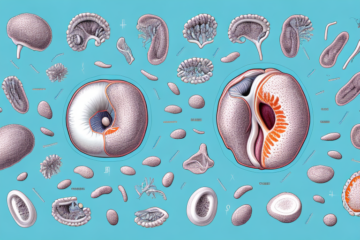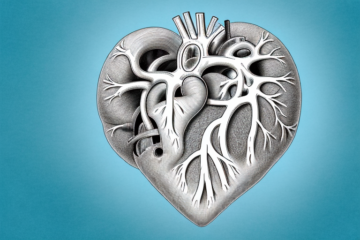Ivemark’s syndrome, also known as asplenia with cardiovascular anomalies, is a rare congenital disorder that affects the development of several organs in the body. This syndrome is characterized by the absence or underdevelopment of a spleen, abnormalities in the heart, as well as other anomalies in the gastrointestinal tract and other organs. In this article, we will provide a comprehensive overview of Ivemark’s syndrome, including information on its causes, symptoms, treatment options, and current research advancements.
What is Ivemark’s syndrome?
Ivemark’s syndrome is a rare type of congenital disorder that affects the development of several organs in the body, including the spleen, heart, and gastrointestinal tract. This syndrome is caused by a genetic defect that affects the formation of these organs during fetal development. The primary characteristic of Ivemark’s syndrome is the absence or underdevelopment of a spleen, which can lead to significant health issues later in life. Other physical characteristics associated with Ivemark’s syndrome include an abnormal positioning of the heart, as well as irregularities in the structure of other organs.
Individuals with Ivemark’s syndrome may also experience immune system deficiencies due to the absence or underdevelopment of the spleen. This can make them more susceptible to infections, particularly those caused by encapsulated bacteria such as Streptococcus pneumoniae. Treatment for Ivemark’s syndrome typically involves managing the symptoms and complications associated with the disorder, such as infections and heart abnormalities.
While Ivemark’s syndrome is a rare disorder, it is important for individuals with a family history of the condition to undergo genetic counseling before planning a pregnancy. This can help identify the risk of passing on the genetic defect to their children and allow for informed decision-making regarding family planning options.
Understanding the anatomy of Ivemark’s syndrome
The anatomy of Ivemark’s syndrome is complex. The primary issue is the absence or underdevelopment of a spleen, which can lead to a weakened immune system, making individuals more susceptible to infections. In addition to the spleen, the heart is also commonly affected in individuals with Ivemark’s syndrome. The heart may be situated on the right side of the chest instead of the left, and may have several other structural abnormalities that can lead to health complications. Other organs, including the liver, pancreas, and gastrointestinal tract, may also be affected in some cases.
It is important to note that Ivemark’s syndrome is a rare genetic disorder, with an estimated incidence of 1 in 10,000 to 1 in 20,000 live births. The condition is caused by mutations in certain genes that are involved in the development of organs during fetal development. While there is no cure for Ivemark’s syndrome, treatment options are available to manage the symptoms and complications associated with the condition. These may include antibiotics to prevent infections, surgery to correct heart defects, and other supportive measures to improve quality of life.
What causes Ivemark’s syndrome?
Ivemark’s syndrome is caused by a genetic defect that affects the formation and development of several organs in the body during fetal development. The exact cause of Ivemark’s syndrome is not fully understood; however, it is believed to occur due to a combination of genetic and environmental factors.
Some of the environmental factors that may contribute to the development of Ivemark’s syndrome include exposure to certain chemicals or toxins during pregnancy, as well as infections or illnesses that the mother may have experienced while pregnant. Additionally, there may be a higher risk of developing Ivemark’s syndrome in families with a history of the condition, indicating a strong genetic component.
Genetic factors and Ivemark’s syndrome
Ivemark’s syndrome is a genetic disorder that is inherited in an autosomal recessive pattern. This means that both parents must carry a copy of the mutated gene for their child to develop the condition. If both parents are carriers, there is a 25% chance that their child will develop Ivemark’s syndrome. However, even if both parents carry the mutation, there is no guarantee that their child will be affected.
It is important to note that Ivemark’s syndrome is a rare disorder, with an estimated incidence of 1 in 100,000 live births. The condition affects multiple organ systems, including the heart, spleen, and lungs. Symptoms can vary widely, but may include congenital heart defects, recurrent infections, and abnormal positioning of organs. Treatment typically involves managing symptoms and complications as they arise, and may include surgery to correct heart defects or remove the spleen.
The role of environmental factors in the development of Ivemark’s syndrome
In addition to genetic factors, some environmental factors may also play a role in the development of Ivemark’s syndrome. These factors may include exposure to toxins, infections, or other environmental factors that can interfere with fetal development. However, the exact environmental factors that can cause Ivemark’s syndrome are not yet fully understood.
Recent studies have suggested that maternal smoking during pregnancy may also increase the risk of Ivemark’s syndrome in the offspring. Nicotine and other harmful chemicals in cigarette smoke can cross the placenta and affect the developing organs, including the heart and spleen. Therefore, pregnant women are advised to quit smoking or avoid exposure to secondhand smoke to reduce the risk of fetal abnormalities, including Ivemark’s syndrome.
Symptoms of Ivemark’s syndrome
The symptoms of Ivemark’s syndrome can vary widely depending on the severity of the condition and the specific organs affected. Common symptoms include a weakened immune system, which can lead to frequent infections, an abnormal positioning of the heart, and structural abnormalities affecting other organs in the body. Some individuals with Ivemark’s syndrome may also experience issues with digestion and absorption of nutrients from food.
In addition to the common symptoms, some individuals with Ivemark’s syndrome may also experience hearing loss, vision problems, and developmental delays. These symptoms can be caused by abnormalities in the inner ear, eyes, and brain, which can occur in some cases of Ivemark’s syndrome.
It is important to note that Ivemark’s syndrome is a rare condition, and not all individuals with the syndrome will experience the same symptoms. Some individuals may have mild symptoms that do not significantly impact their daily lives, while others may have more severe symptoms that require ongoing medical care and support.
Physical characteristics of Ivemark’s syndrome
Individuals with Ivemark’s syndrome may exhibit physical characteristics such as a rounded face, a short neck, and a low hairline. They may also have a small jaw and a cleft palate, and may experience abnormal heart sounds or murmurs due to heart abnormalities. Other physical characteristics may include an enlarged liver and spleen, as well as abnormalities in the structure and function of other organs in the body.
In addition to the physical characteristics mentioned above, individuals with Ivemark’s syndrome may also have abnormalities in their immune system, leading to an increased risk of infections. They may also experience difficulty with breathing due to abnormalities in their lungs or airways.
Furthermore, some individuals with Ivemark’s syndrome may have developmental delays or intellectual disabilities. They may also experience hearing loss or vision problems, and may require specialized medical care throughout their lives.
Common health problems associated with Ivemark’s syndrome
Individuals with Ivemark’s syndrome are at increased risk for several health complications. The absence or underdevelopment of a spleen can lead to a weakened immune system, making them more susceptible to infections. They are also at increased risk for heart problems, including heart failure, arrhythmias, and other structural abnormalities affecting the heart. Additionally, they may experience problems digesting and absorbing nutrients from food, leading to malnutrition and other health issues.
Another common health problem associated with Ivemark’s syndrome is the increased risk of developing certain types of cancer, such as leukemia and lymphoma. This is due to the weakened immune system and the inability of the body to fight off abnormal cells. Regular cancer screenings are recommended for individuals with Ivemark’s syndrome.
In some cases, individuals with Ivemark’s syndrome may also experience developmental delays or intellectual disabilities. This can be due to structural abnormalities in the brain or other parts of the body. Early intervention and therapy can help improve outcomes for these individuals.
How is Ivemark’s syndrome diagnosed?
Ivemark’s syndrome is typically diagnosed through a combination of physical examination, genetic testing, and imaging studies. A doctor may perform a physical examination to look for characteristic physical features of the disorder, as well as take a detailed medical history to look for any symptoms or complications associated with the condition. Genetic testing can also be performed to detect any mutations associated with Ivemark’s syndrome. Imaging studies, such as ultrasounds, CT scans, or MRIs, can also be used to look for abnormalities in the structure of the organs affected by the disorder.
In addition to these diagnostic methods, doctors may also perform blood tests to check for any abnormalities in blood cell counts or liver function, as these can be indicators of Ivemark’s syndrome. It is important for individuals with a family history of the disorder or those experiencing symptoms to seek medical attention and undergo appropriate testing for an accurate diagnosis.
Genetic testing and diagnosis of Ivemark’s syndrome
Genetic testing is a key component in the diagnosis of Ivemark’s syndrome. A blood test can be performed to look for mutations in genes associated with the disorder. Genetic testing can also help identify carriers of the mutated gene, which can be useful for family planning purposes.
In addition to genetic testing, diagnosis of Ivemark’s syndrome may also involve imaging tests such as echocardiography, which can detect abnormalities in the heart, and abdominal ultrasound, which can reveal malformations in the organs. These tests can help doctors determine the severity of the condition and develop an appropriate treatment plan.
Imaging techniques used to diagnose Ivemark’s syndrome
Imaging studies, such as ultrasounds, CT scans, or MRIs, can also be used to diagnose Ivemark’s syndrome. These tests can identify abnormalities in the structure of the organs affected by the disorder, including the heart, spleen, and other organs.
In addition to imaging studies, blood tests may also be conducted to check for abnormalities in the immune system and blood cell counts. Genetic testing may also be recommended to confirm the diagnosis of Ivemark’s syndrome and to identify any underlying genetic mutations that may be contributing to the disorder.
Treatment options for Ivemark’s syndrome
Treatment options for Ivemark’s syndrome depend on the specific symptoms and complications of each individual case. No cure for Ivemark’s syndrome currently exists. However, there are several treatment options available to manage symptoms and prevent complications.
Some of the treatment options for Ivemark’s syndrome include surgery to correct any structural abnormalities, such as heart defects or malformations of the spleen or liver. Medications may also be prescribed to manage symptoms such as infections or low platelet counts. In some cases, a bone marrow transplant may be necessary to treat severe immune system dysfunction. It is important for individuals with Ivemark’s syndrome to receive regular medical care and monitoring to manage their condition and prevent complications.
Medications for managing symptoms of Ivemark’s syndrome
Medications may be prescribed to manage symptoms of Ivemark’s syndrome, such as antibiotics to prevent infections in individuals with a weakened immune system. Additionally, medications may be prescribed to manage heart conditions, such as arrhythmias or heart failure.
It is important to note that medication management for Ivemark’s syndrome should be closely monitored by a healthcare professional. Dosages may need to be adjusted based on the individual’s response to the medication and any potential side effects. It is also important to inform all healthcare providers of any medications being taken to prevent any potential drug interactions.
Surgical interventions for treating complications of Ivemark’s syndrome
In some cases, surgical interventions may be required to treat complications of Ivemark’s syndrome. For example, surgery may be required to correct structural abnormalities in the heart or other organs, such as the gastrointestinal tract or liver.
Another potential complication of Ivemark’s syndrome is the development of infections, particularly in the lungs or urinary tract. In some cases, surgery may be necessary to remove infected tissue or drain abscesses.
It is important to note that surgical interventions for Ivemark’s syndrome are typically only used to address specific complications and are not a cure for the underlying condition. Patients with Ivemark’s syndrome will require ongoing medical management and monitoring to address any potential complications and ensure the best possible quality of life.
Lifestyle modifications for living with Ivemark’s syndrome
Lifestyle modifications may also be recommended for individuals with Ivemark’s syndrome to manage symptoms and prevent complications. This may include dietary changes to ensure adequate nutrient intake, regular exercise, and other recommendations to maintain overall health and wellbeing.
In addition to dietary changes and regular exercise, individuals with Ivemark’s syndrome may benefit from respiratory therapy to manage breathing difficulties. This may include the use of supplemental oxygen or respiratory devices to improve lung function and prevent respiratory infections.
It is also important for individuals with Ivemark’s syndrome to receive regular medical check-ups and screenings to monitor for any potential complications, such as heart or liver problems. Early detection and treatment can help prevent serious health issues and improve overall quality of life.
Coping strategies for families affected by Ivemark’s syndrome
Diagnosis of Ivemark’s syndrome can be overwhelming for families. It is important to seek out support from healthcare professionals, as well as support groups for families affected by Ivemark’s syndrome. Additionally, it may be helpful to connect with other families affected by the disorder to gain insight and advice.
It is also important for families to educate themselves about Ivemark’s syndrome and its potential complications. This can help them better understand the disorder and how to manage it. Families should work closely with their healthcare team to develop a comprehensive care plan that addresses the unique needs of their loved one with Ivemark’s syndrome.
Finally, families should prioritize self-care and seek out resources to help them manage the emotional toll of caring for a loved one with a chronic illness. This may include therapy, support groups, or other forms of self-care such as exercise or meditation. By taking care of themselves, families can better support their loved one with Ivemark’s syndrome and improve their overall quality of life.
Current research and advancements in the treatment of Ivemark’s syndrome
While there is no cure for Ivemark’s syndrome, ongoing research is investigating potential new treatments and interventions to manage symptoms and prevent complications. Advancements in genetic testing and imaging technology are also helping to improve diagnosis and treatment of the disorder.
One promising area of research is the use of gene therapy to treat Ivemark’s syndrome. This involves introducing healthy genes into the body to replace or supplement the faulty genes that cause the disorder. While still in the early stages of development, initial studies have shown promising results in animal models.
Outlook for individuals with Ivemark’s syndrome
Outlook for individuals with Ivemark’s syndrome varies widely depending on the severity of the disorder and the specific complications affecting each individual case. However, with ongoing medical care and management of symptoms and complications, individuals with Ivemark’s syndrome can live long and healthy lives.
It is important for individuals with Ivemark’s syndrome to receive regular medical check-ups and screenings to monitor for any potential complications, such as heart or kidney problems. In some cases, surgery may be necessary to address these issues. Additionally, individuals with Ivemark’s syndrome may benefit from working with a team of healthcare professionals, including specialists in cardiology, gastroenterology, and immunology, to manage their care and ensure the best possible outcomes.
Importance of early diagnosis and intervention in managing Ivemark’s syndrome
Early diagnosis and intervention is critical for managing Ivemark’s syndrome and preventing complications. If you suspect you or your child may have Ivemark’s syndrome, it is essential to seek out medical care and obtain a proper diagnosis as soon as possible.
Once a diagnosis of Ivemark’s syndrome has been confirmed, it is important to work closely with a team of healthcare professionals to develop a comprehensive treatment plan. This may include regular monitoring of the heart and other organs, as well as surgical interventions to address any abnormalities or complications that may arise. In addition, individuals with Ivemark’s syndrome may benefit from ongoing support from a genetic counselor or other mental health professional to help them cope with the challenges of living with a rare genetic disorder.










